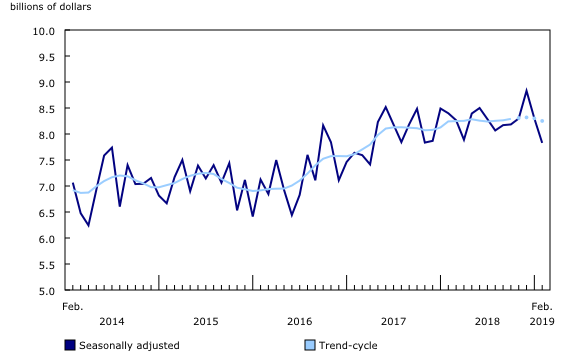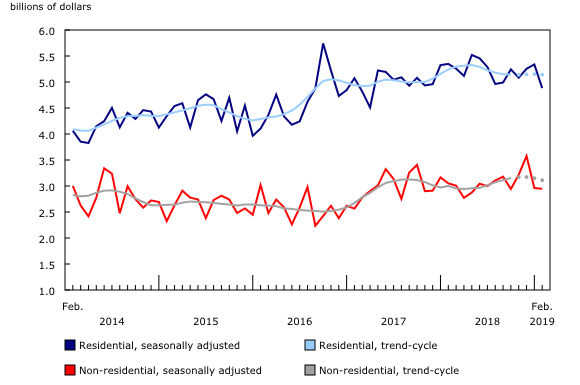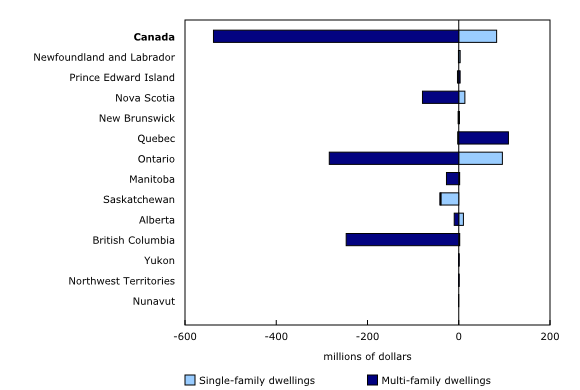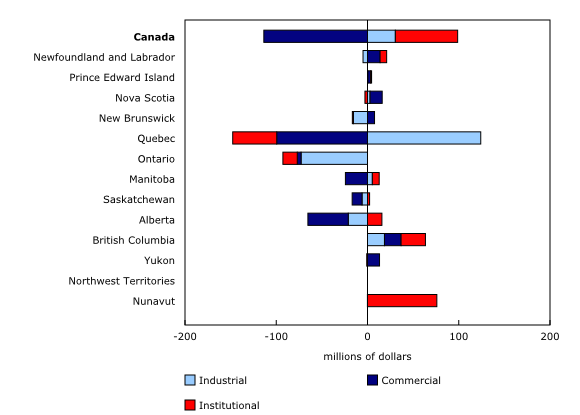Building permits, February 2019
Archived Content
Information identified as archived is provided for reference, research or recordkeeping purposes. It is not subject to the Government of Canada Web Standards and has not been altered or updated since it was archived. Please "contact us" to request a format other than those available.
Released: 2019-04-08
$7.8 billion
February 2019
-5.7% 
(monthly change)
$58.2 million
February 2019
46.8% 
(monthly change)
$24.6 million
February 2019
23.2% 
(monthly change)
$117.9 million
February 2019
-31.0% 
(monthly change)
$90.2 million
February 2019
-8.8% 
(monthly change)
$1,705.2 million
February 2019
5.1% 
(monthly change)
$3,096.8 million
February 2019
-8.3% 
(monthly change)
$222.1 million
February 2019
-14.1% 
(monthly change)
$108.2 million
February 2019
-34.0% 
(monthly change)
$895.5 million
February 2019
-5.2% 
(monthly change)
$1,394.6 million
February 2019
-11.5% 
(monthly change)
$17.3 million
February 2019
308.8% 
(monthly change)
$1.7 million
February 2019
62.3% 
(monthly change)
$96.8 million
February 2019
356.8% 
(monthly change)
Canadian municipalities issued $7.8 billion worth of building permits in February, down 5.7% from the previous month. The decline was largely due to lower construction intentions for multi-family dwellings.
Multi-family dwellings lower in February
The value of permits for residential buildings declined 8.5% in February to $4.9 billion, the lowest level since April 2017. The decrease was largely the result of lower construction intentions for multi-family dwellings in Ontario and British Columbia. Despite the monthly decline, the value of multi-family permits has shown notable strength over the past year.
Non-residential sector down slightly
Municipalities issued $2.9 billion worth of non-residential building permits in February, edging down 0.5% from the previous month. The decline stemmed from lower values of commercial permits (-$114 million), which posted sharp increases in November and December.
The value of institutional permits rose 11.6%, the first increase in five months. A high-value permit issued for the Qikiqtani Correctional Healing Centre in Nunavut contributed to the gain.
Provincial update
British Columbia issued $1.4 billion of permits in February, down $181 million from January. Lower construction intentions for multi-family dwellings more than offset gains in all other components. The value of permits in the census metropolitan area of Vancouver declined 20.5% to $800 million. This followed three consecutive months where permits were above the $1.0-billion mark.
The value of permits in Saskatchewan was down 34.0% to $108 million, as every component except institutional buildings declined. The decrease partly reflected changes to building energy codes that went into effect in the province on January 1, 2019. The largest decrease was in the single-family dwelling component.
The value of permits for single-family homes in Saskatchewan have been on a general downward trend since 2013. In 2018, the province issued $596 million worth of single-family permits, the lowest value since 2006. The Association of Regina Realtors and the Saskatoon Region Association of Realtors both reported a decrease in the number of home sales in 2018.
Note to readers
Unless otherwise stated, this release presents seasonally adjusted data, which facilitate month-to-month comparisons by removing the effects of seasonal variations. For information on seasonal adjustment, see Seasonally adjusted data – Frequently asked questions.
The Building Permits Survey covers over 2,400 municipalities, representing 95% of the Canadian population. The communities representing the other 5% of the population are very small and their levels of building activity have little impact on the total for the entire population.
Building permits data are used as a leading indicator of activity in the construction industry.
The value of planned construction activities presented in this release excludes engineering projects (such as waterworks, sewers or culverts) and land.
For the purposes of this release, the census metropolitan area of Ottawa–Gatineau (Ontario/Quebec) is divided into two areas: the Ottawa part and the Gatineau part.
Unless otherwise specified, the highlights refer to seasonally adjusted current dollars and are ranked in terms of dollar change rather than percentage change.
Building components
Single-family dwellings: Residential buildings containing only one dwelling unit (for example, single-detached house, bungalow, linked home [linked at the foundation]).
Multi-family dwellings: Residential buildings containing multiple dwelling units (for example, apartment, apartment condominium, row house, semi-detached).
Industrial buildings: Buildings used in the transformation or production of goods, or related to transportation and communication.
Commercial buildings: Buildings used in trade or distribution of goods and services.
Institutional and government buildings: Buildings used to house public and semi-public services such as those related to health and welfare, education, or public administration, as well as buildings used for religious services.
Revision
Unadjusted data for the current reference month are subject to revision based on late responses. As per standard Statistics Canada practices, unadjusted data for the previous year have been revised. Seasonally adjusted data have also been revised for the previous three years.
Trend-cycle estimates have been added to the charts as a complement to the seasonally adjusted series. Both seasonally adjusted data and trend-cycle estimates are subject to revision as additional observations become available. These revisions could be large and even lead to a reversal of movement, especially at the end of the series. The higher variability associated with trend-cycle estimates is indicated with a dotted line on the chart.
For information on trend-cycle data, see the StatCan Blog and Trend-cycle estimates – Frequently asked questions.
Next release
Data on building permits for March will be released on May 10.
Products
Statistics Canada has a new Housing Market Indicators Dashboard. This web application provides access to key housing market indicators for Canada, by province and by census metropolitan area. These indicators are automatically updated with new information from monthly releases, giving users access to the latest data.
Contact information
For more information, or to enquire about the concepts, methods or data quality of this release, contact us (toll-free 1-800-263-1136; 514-283-8300; STATCAN.infostats-infostats.STATCAN@canada.ca) or Media Relations (613-951-4636; STATCAN.mediahotline-ligneinfomedias.STATCAN@canada.ca).
- Date modified:





